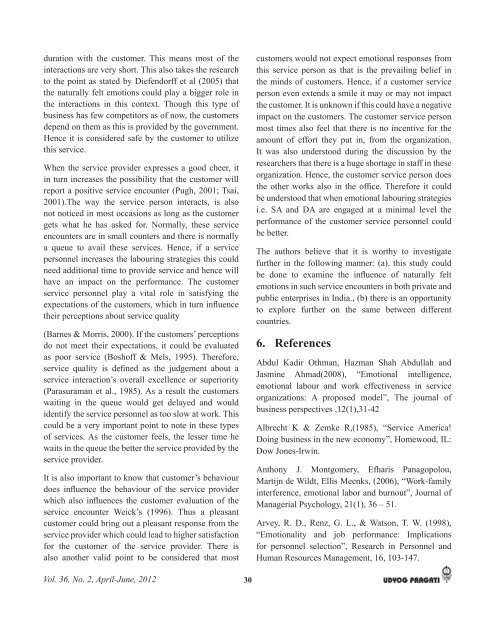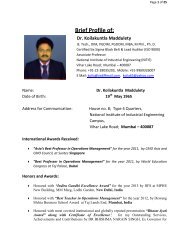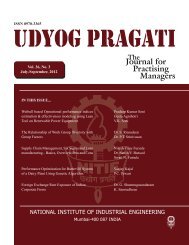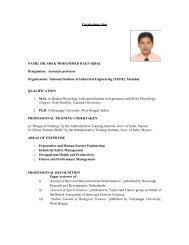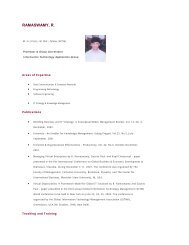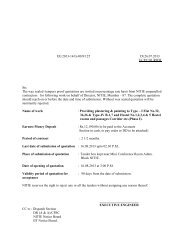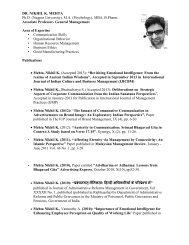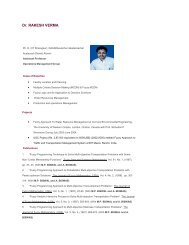Apr-Jun.12 - the Nitie
Apr-Jun.12 - the Nitie
Apr-Jun.12 - the Nitie
You also want an ePaper? Increase the reach of your titles
YUMPU automatically turns print PDFs into web optimized ePapers that Google loves.
duration with <strong>the</strong> customer. This means most of <strong>the</strong><br />
interactions are very short. This also takes <strong>the</strong> research<br />
to <strong>the</strong> point as stated by Diefendorff et al (2005) that<br />
<strong>the</strong> naturally felt emotions could play a bigger role in<br />
<strong>the</strong> interactions in this context. Though this type of<br />
business has few competitors as of now, <strong>the</strong> customers<br />
depend on <strong>the</strong>m as this is provided by <strong>the</strong> government.<br />
Hence it is considered safe by <strong>the</strong> customer to utilize<br />
this service.<br />
When <strong>the</strong> service provider expresses a good cheer, it<br />
in turn increases <strong>the</strong> possibility that <strong>the</strong> customer will<br />
report a positive service encounter (Pugh, 2001; Tsai,<br />
2001).The way <strong>the</strong> service person interacts, is also<br />
not noticed in most occasions as long as <strong>the</strong> customer<br />
gets what he has asked for. Normally, <strong>the</strong>se service<br />
encounters are in small counters and <strong>the</strong>re is normally<br />
a queue to avail <strong>the</strong>se services. Hence, if a service<br />
personnel increases <strong>the</strong> labouring strategies this could<br />
need additional time to provide service and hence will<br />
have an impact on <strong>the</strong> performance. The customer<br />
service personnel play a vital role in satisfying <strong>the</strong><br />
<br />
<strong>the</strong>ir perceptions about service quality<br />
(Barnes & Morris, 2000). If <strong>the</strong> customers’ perceptions<br />
do not meet <strong>the</strong>ir expectations, it could be evaluated<br />
as poor service (Boshoff & Mels, 1995). Therefore,<br />
<br />
service interaction’s overall excellence or superiority<br />
(Parasuraman et al., 1985). As a result <strong>the</strong> customers<br />
waiting in <strong>the</strong> queue would get delayed and would<br />
identify <strong>the</strong> service personnel as too slow at work. This<br />
could be a very important point to note in <strong>the</strong>se types<br />
of services. As <strong>the</strong> customer feels, <strong>the</strong> lesser time he<br />
waits in <strong>the</strong> queue <strong>the</strong> better <strong>the</strong> service provided by <strong>the</strong><br />
service provider.<br />
It is also important to know that customer’s behaviour<br />
<br />
<br />
service encounter Weick’s (1996). Thus a pleasant<br />
customer could bring out a pleasant response from <strong>the</strong><br />
service provider which could lead to higher satisfaction<br />
for <strong>the</strong> customer of <strong>the</strong> service provider. There is<br />
also ano<strong>the</strong>r valid point to be considered that most<br />
customers would not expect emotional responses from<br />
this service person as that is <strong>the</strong> prevailing belief in<br />
<strong>the</strong> minds of customers. Hence, if a customer service<br />
person even extends a smile it may or may not impact<br />
<strong>the</strong> customer. It is unknown if this could have a negative<br />
impact on <strong>the</strong> customers. The customer service person<br />
most times also feel that <strong>the</strong>re is no incentive for <strong>the</strong><br />
amount of effort <strong>the</strong>y put in, from <strong>the</strong> organization.<br />
It was also understood during <strong>the</strong> discussion by <strong>the</strong><br />
researchers that <strong>the</strong>re is a huge shortage in staff in <strong>the</strong>se<br />
organization. Hence, <strong>the</strong> customer service person does<br />
<br />
be understood that when emotional labouring strategies<br />
i.e. SA and DA are engaged at a minimal level <strong>the</strong><br />
performance of <strong>the</strong> customer service personnel could<br />
be better.<br />
The authors believe that it is worthy to investigate<br />
fur<strong>the</strong>r in <strong>the</strong> following manner: (a). this study could<br />
<br />
emotions in such service encounters in both private and<br />
public enterprises in India., (b) <strong>the</strong>re is an opportunity<br />
to explore fur<strong>the</strong>r on <strong>the</strong> same between different<br />
countries.<br />
<br />
Abdul Kadir Othman, Hazman Shah Abdullah and<br />
Jasmine Ahmad(2008), “Emotional intelligence,<br />
emotional labour and work effectiveness in service<br />
organizations: A proposed model”, The journal of<br />
business perspectives ,12(1),31-42<br />
Albrecht K & Zemke R,(1985), “Service America!<br />
Doing business in <strong>the</strong> new economy”, Homewood, IL:<br />
Dow Jones-Irwin.<br />
Anthony J. Montgomery, Efharis Panagopolou,<br />
Martijn de Wildt, Ellis Meenks, (2006), “Work-family<br />
interference, emotional labor and burnout”, Journal of<br />
Managerial Psychology, 21(1), 36 – 51.<br />
Arvey, R. D., Renz, G. L., & Watson, T. W. (1998),<br />
“Emotionality and job performance: Implications<br />
for personnel selection”, Research in Personnel and<br />
Human Resources Management, 16, 103-147.<br />
Vol. 36, No. 2, <strong>Apr</strong>il-June, 2012<br />
30


